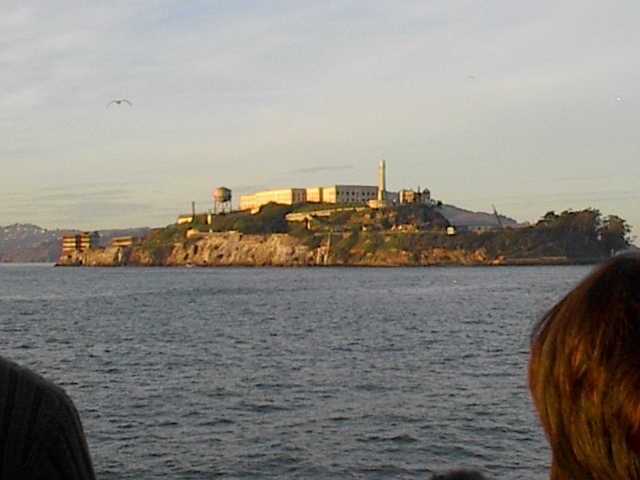 |
The Island received its
name in 1775 when Spanish explorer Juan Manuel de Ayala charted the
San Francisco Bay and named it La Isla de los Alcatraces, which translated
to "Island of the Pelicans." The small-uninhabited island
had little going for it with its swift currents, minimal vegetation,
and barren ground.
Seventy-two years later in 1847, the US Army took
notice of "the Rock" and its strategic value as a military
fortress. Topographical engineers began conducting geological surveys
and by 1853, U.S. Army Engineers started constructing a military
fortress along with the Pacific Coast's first operating lighthouse.
The discovery of gold along the American River and
California in 1848, brought shiploads of miners from around the
world into California seeking the precious metal. As word spread
around the globe of abundant wealth in California, the United States
government would evoke security measures to protect its land and
mineral resources from seizure by other countries. |
After several years of laborious construction and
several armament expansions, Alcatraz was set as the United States Western
symbol of military strength. The new military fortress featured long-range
iron cannons and four massive 36,000-pound, 15 inch Rodman guns capable
of sinking mammoth hostile ships three miles away. Alcatraz's guns could
fire 6,949 pounds of iron shot in one barrage. Though the fortress fired
only one 400 pound canon round at an unidentified ship and missed, the
Island had lived up to its self-given proclamation as an icon of U.S.
military power.
Within a few decades the Island's role as a military
fortress would start to fade away and its defenses would become obsolete
by more modern weaponry standards. In 1861, Alcatraz started to receive Civil War
prisoners because of its natural isolation created by the surrounding
waters. In 1898, the Spanish-American war took the prisoner population
from a mere twenty-six, to over four hundred and fifty. In 1906 following
the catastrophic San Francisco earthquake, hundreds of civilian prisoners
were transferred to the island for safe confinement. By 1912, a large
cell house was constructed on the island's central crest and by the late
1920's, the three-story structure was nearly at capacity.
After the Civil War, Confederate sympathizers caught
celebrating the death of President Lincoln were sent to Alcatraz. In 1868,
the Army designated Alcatraz as a prison for military convicts and malcontents
of society. By the late 1800’s and early 1900’s, Indian chiefs and tribal
leaders of Arizona and Alaska were incarcerated along with some of the
worst thieves, deserters, rapists and repeated escapees from the Army.
Alcatraz again became a disciplinary barracks for U.S. Army military incorrigibles,
as well as a health resort when soldiers returning from the Spanish-American
War convalesced there.
On the morning of the 1906 San Francisco earthquake,
Alcatraz shook, but sustained little damage. That same year, four prisoners
tried to paddle to the mainland on a butter vat, only to have strong currents
bring them back. Driftwood was used for escape attempts in 1912, 1916,
1927 and a ladder was used during an escape attempt in 1929. All of the
men were captured or surrendered, victims of the cruel currents and cold
water. In 1911, Alcatraz was officially named the United States Disciplinary
Barracks - an official Army prison which included both U.S. Army prisoners
as well as German seamen who became prisoners of war.
The social upheaval of the 1920’s and
1930’s, and rampant crime sweeping America, provided Alcatraz with new
life. Daring escapes, gang-related murders and mass rioting were a menace
to an orderly prison. Attorney General Homer Cummings supported J. Edgar
Hoover in creating a facility which would instill fear in would-be criminals
by creating a place where prisoners could be safely controlled and could
not escape. In 1933, the prison facility was formally turned over to the
Federal Bureau of Prisons. During 1934, Alcatraz became an escape-proof,
maximum security prison, where only the most hardened convicts were brought.
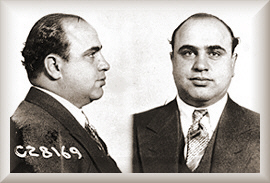
"Al Capone" |
The first residents of the newly
created Alcatraz received numbers 1-32, with Frank Bolt having the
distinction of being Federal Prisoner #1 while serving a five-year
sentence for Sodomy. He was followed by Charles Copp (Robbery and
attempted Assault); Leon Gregory (Robbery, Assault and AWOL); Joseph
Harrison (Sodomy); Forrest Henry (Robbery and Assault); Clyde Hicks
(Sodomy); Ralph Hills (Robbery and Assault); Albert Hoke (Robbery);
Alan Hood (Sodomy); and Frederick Holme (Sodomy and False Enlistment)
to round out the first ten inmates.
Al Capone was the first celebrity on the first train to Alcatraz,
arriving in August 1934. He was given number 85.
Guards armed with machine guns, insured there were no escapes. |
Many convicts found Alcatraz the end of
their career in crime, as well as the end of their lives. For 29 years,
the fog-enshrouded island, with its damp, cold winds and isolation, made
Alcatraz one of America's safest prisons. The shell of steel and reinforced
concrete confined ruthless men to a life of deprivation, rules and routines
that proved almost intolerable. When one adds the fact that the convicts
could hear the party boats pass by, and see some of the San Francisco
city lights, it is little wonder that some preferred death to this kind
of isolation. Failure to acquiesce to prison rules resulted in confinement
in ‘D’ block, the treatment unit. Here, men could leave their four-by-eight
cells only once in seven days for a brief, ten-minute shower.
Life was hard on Alcatraz, just the way that Warden Johnson envisioned
it. His motto was "Take each day of your sentence, one day at a time.
Don’t think how far you have to go, but how far you’ve come." For
many prisoners, Alcatraz became synonymous with hell.
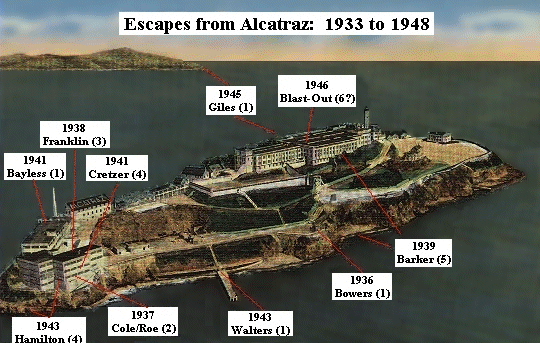 |
There were a number of escape
attempts from Alcatraz, but the bloodiest occurred on May 2, 1946,
involving Bernard Coy, Joseph Cretzer, Sam Shockley, Clarence Carnes,
Marvin Hubbard and Miran Thompson.
It cost the lives of three inmates and two
guards, with 17 guards and one prisoner wounded. The trial afterward,
resulted in the execution of two more convicts who took part in
the aborted escape.Attorney General Robert Kennedy officially
closed the doors of Alcatraz on March 21, 1963. From 1963 to 1969,
the prison was unoccupied.
Today, it is maintained by the Golden Gate
National Recreation Area where almost a million visitors per year
pay to see ‘the Rock’. |
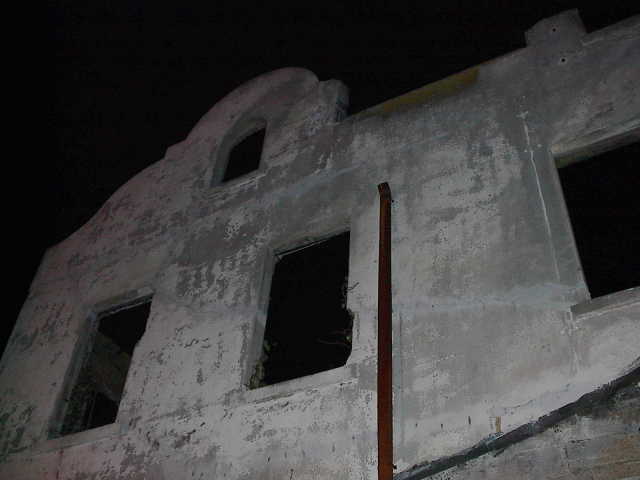 |
Whoever, or whatever, lurks in the shadows
can be heard, seen and felt. As parapsychologists suggest, where so
much trauma and negative emotion have occurred, there is bound to
be residual energy … and Alcatraz has the feel of an immense haunted
house, complete with fog and restless spirits.
Here are some of the stories:
During a visit to Alcatraz by the
television show, Sightings, in 1992, several of the Park Service
staff confirmed the haunted history of the prison. Many rangers
had experienced unexplainable crashing sounds, cell doors mysteriously
closing, unearthly screams and intense feelings of being watched.
Sightings called on psychic investigator Peter James to walk through
portions of the abandoned prison to get his impressions. James began
to pick up on the voices of the tortured souls driven mad since
its inception as a prison. He also sensed unusual vibrations of
abuse, mistreatment, fear and pain. His overall impression of Alcatraz
was that it had an energy like no other he had ever experienced,
persistent and overwhelming intensity that engulfed the island. |
Some of the more haunted locations on Alcatraz
appear to be the Warden’s house, the hospital, the laundry room and the
cell block ‘C’ utility door where convicts Coy, Cretzer and Hubbard died
during their escape attempt in 1946.
Most of the paranormal activity on Alcatraz seems
to occur around areas associated with the penitentiary’s worst tragedies.
One of them is the block ‘C’ utility corridor, cell blocks ‘A’ and ‘B’,
with the eeriest area centering around cell 14-D -where it is always cold.
According to May, gifted psychic Sylvia Brown, accompanied by a CBS news
team, investigated parts of Alcatraz. As Brown toured the prison hospital,
she picked up cards and notes tacked up on a wall, and the letter ‘S’.
A ranger confirmed that the ‘S’ probably stood for Robert Stroud who spent
a ten-and-a-half years in the hospital, in the very room where they were
standing.
He also had hundreds of notes and cards tacked up all around him. Brown
sensed strong energy in what used to be the therapy room, and the prison
laundry room, where at least one prisoner was murdered.
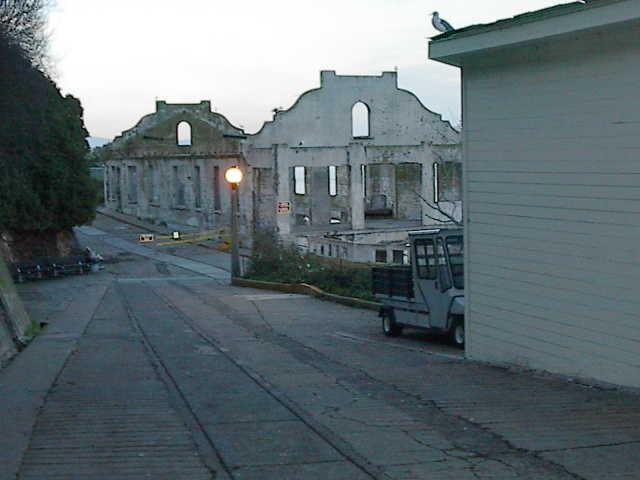 |
The most haunted area of Alcatraz
is the ‘D’ cell block, or solitary, as it was often called. To most
of those who go there, a feeling of sudden intensity pervades the
cells and corridor. Some rangers refuse to go there alone. It is
intensely sold in certain cells, far colder than normal -especially
in cell 14-D. This cell is oftentimes so cold, that wearing a jacket
barely helps as the surrounding area is twenty degrees colder. It
is no wonder the area is called ‘the Hole’.
A former guard related his stories about
cell block ‘D’ (particularly cells 12 and 14), and the frightening
remnant energy lingering in the subterranean portion of the prison.
During his stint in the mid-1940’s, convicts were often confined
in one of the 14 cells in ‘D’ blocks. Cells 9-14 were called ‘the
Hole’, because they contained no windows, and only one light which
could be turned off by the guards. The darkness made it seem like
a hole in the ground -hence the name. On one occasion, an inmate
was locked in ‘the Hole’. Within seconds, the inmate began screaming
that someone with glowing eyes was in there with him. Tales of a
ghostly presence wandering the darkened corridors in clothing from
the late 1800’s were a continual source of practical joking |
among the guards, so the convict's pleas of being ‘attacked’ were ignored.
The man’s screaming continued
well into the night, until there was silence. The following day, the guards
inspected the cell -the convict was dead, a horrible expression etched on
his face and noticeable hand-marks around his throat. The autopsy revealed
that the strangulation was not self-inflicted.
Some say he was strangled by a guard
who had enough of the man’s screaming, although no guard ever admitted
it, even to the other guards.
Others believed it was the restless, evil spirit of a former inmate who
exacted his vengeance on yet another helpless soul. To add to the mystery,
the day after the tragedy, several guards, performing a line-up of the
convicts, counted one too many people. At the end of the line, the guards
saw an extra body -that of the recently deceased convict. As everyone
looked on in stunned silence, the figure of the ghostly convict vanished
into thin air.
A number of guards from 1946 through 1963,
experienced something out of the ordinary at one time or another. From
the outer rim on the grounds to the deepest caverns, there was constant
talk of people sobbing and moaning, horrible smells and cold spots. Groups
of phantom prisoners and soldiers have also appeared in front of startled
guards, guests and the families who lived on the island.
Sometimes the old lighthouse, long since
destroyed, has appeared out of a dense fog, accompanied by a ghostly whistling
sound, and a green flashing light which passed slowly around the island,
just as if the lighthouse was still active. It would then vanish before
the startled eyes of guards and visitors. Phantom cannon shots, gun shots
and screams often sent seasoned guards running for cover, thinking that
prisoners had escaped and obtained weapons. Each time, there was no explanation.
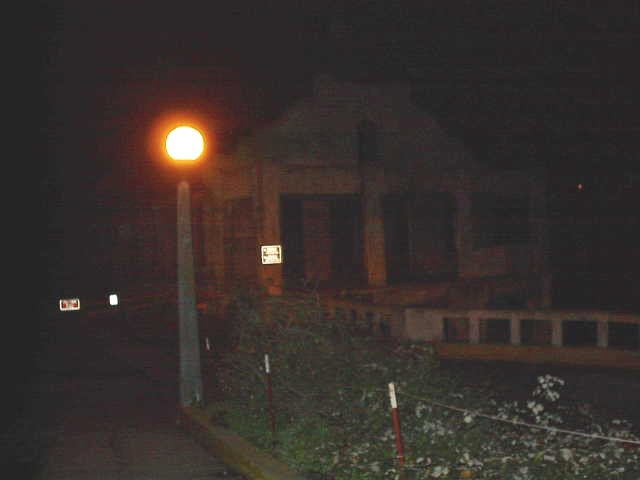 |
A deserted laundry room
would sometimes emanate a strong scent of smoke, as if something was
on fire. The sensation of the choking smoke would drive guards out
of the room, only to return a few minutes later, the area now completely
smoke free. The phantom smoke occurred many times over the years.
Even Warden Johnston, who didn’t believe in ghosts, encountered the
unmistakable sounds of a woman sobbing, as if coming from inside the
walls of the dungeon while he accompanied a number of guests on a
tour of the facility. As if that weren’t enough, an icy, cold wind
blew through the group, chilling them to the bone, just as the sobbing
stopped.
The now burned-out shell of the Warden’s house has
also been a focal point for sightings since the 1940’s. During a
Christmas party, several guards witnessed the chilling apparition
of a man wearing a gray suit, brimmed cap, and mutton-chop sideburns.When
the men saw the apparition, the room turned deathly cold, the fire
in the Ben Franklin stove was extinguished and, after less than
a minute, the man vanished. |
Documentary report only. No ghost hunt
or investigation conducted.
Photographs
Click on the thumbnails to view the larger image
|